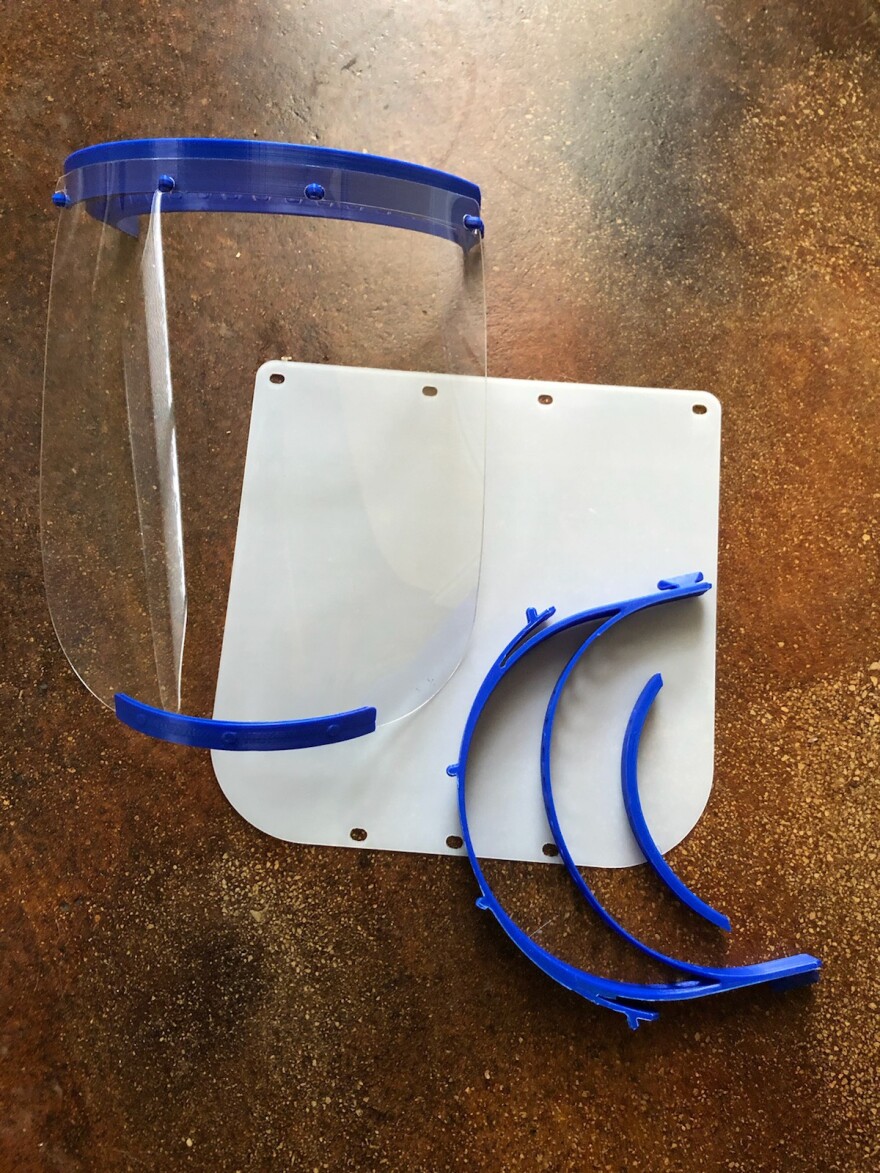Drue Placette stares at his three monitors, trying to find the right design for a doctor’s face shield he will print using his fleet of more than a dozen 3D printers.
In his office at Canopener Labs, the fabrication studio he runs with Dale Bracey, he is surrounded by piles of paper, computer parts, tools and a hodge podge of his life ranging from carrot seeds to an ammo box spilling over with a belt of large bullets.
He digs through a website of open-source designs, but ultimately can’t find the file he’s looking for.
He has to call Thuy Dihn the originator of this particular project and owner of HaniMade studio. Dihn saw the need for personal protective equipment (PPE) — to keep doctors safe from infection — and wanted to help.
Little did she know her post on Instagram would garner so much attention leading to support and donations.
“Everything is moving so fast,” she said.
And now she and a group of two dozen volunteers are printing several hundred a day to give to doctors and hospitals.
Dihn’s effort is just one of the hundreds ramping up across the country from people in the so-called maker movement. The COVID-19 crisis has seen a groundswell of community support from 3D printers, fabricators and DIYers.
Face shields, swabs, masks and even emergency ventilators are being created — but will hospitals use them?
“I chose this particular file because it's most familiar to what doctors are already using,” said Dihn, adding people feel better about the familiar.
“Making them is easy. Getting hospitals to use them is the hard part,” said Placette
So far these are going to small clinics and nursing homes, he said. They have some hospitals evaluating the gear currently.
Why are hospitals “harder?” First: they don’t actually need PPE right now.
“Right now, we’re fine,” said Dr. Ian Thompson, president of Christus Santa Rosa Medical Center.
He says they are evaluating some of the PPE offered. He — and many others — have reservations about the masks they’re seeing, but are happier with the face shields.
Many scientists have raised concern with masks that are printed or sewn for a variety of reasons, including the ability to fit to the user and the protection offered by the material used.
“There are some science to suggest that some of the do-it-yourself masks, do not achieve the same droplet precaution that a standard issue mask would,” said Thompson

“A plastic shield is a plastic shield,” he said.
Though, they can reuse the ones they have after disinfecting. He said procuring manufactured masks and shields are still the goal, and marshalling those resources judiciously.
For him, he would rather the folks trying to make the equipment just not get sick.
“Have those folks stay home and have those folks give blood, that’s the main thing they can do right now,” he said.
The next problem is each hospital in the area has to create its own process. Some have partnered, but largely each is a fiefdom of its own, with a set of established stakeholders who have to sign off: representatives of doctors and nurses who need to feel safe about anything used, procurement people, legal people, testing people and admin people.
There a host of concerns around quality assurance and specifications, all which would be reviewed before anything was signed off on, Volk said.
Finally, many never conceived they would be in a situation where they would need to consider PPE like this.
“I have never thought that this would ever be the case before. This is absolutely unprecedented,” said Dr. Emily Volk, Senior Vice President for Clinical Services with San Antonio’s University Health System. They too currently have enough PPE but aren’t ruling out unknown situations.
“We want to make sure our staff is safe,” she said. “So if we get to a point where we cannot use standard equipment, we are open to any reasonable solution to that problem.”
University Health also has two ongoing efforts spearheaded by staff to source medical-grade-like n95 and other masks from local manufacturers. Testing is ongoing in the endeavor led by two medical staffers.
The situation is a moving target. The surge could never come, or it could be even worse than expected.
Hospitals might never use the things donated, or they might need even more.
And the bar could drop on what they accept.
There are a lot of unknowns, as the country braces for as many as 100,000 people to die in coming weeks.
What hospitals can say for sure is they are grateful to the community.
Paul Flahive can be reached at Paul@tpr.org or on Twitter @paulflahive.





